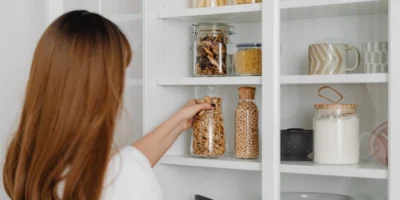This guide outlines how to throw paint away safely, ideas for storing it, and what to avoid doing.
After painting or renovating, the question often arises: what to do with the leftover paint or paint buckets? Paint buckets and the leftovers usually end up in basements, garages or storage rooms. But should you store the paint buckets or should you dispose of the paint straight away?
Paints and varnishes are so-called hazardous substances. In liquid form, they must not be thrown into household waste. Find out how and where to dispose of leftover paint, empty paint buckets and varnishes.
How to throw paint away when it is still liquid
But you cannot simply dispose of liquid paint in your household waste, as it is considered hazardous waste. Paints and varnishes – especially in their liquid form – are so-called ‘problem substances’. This is the name given to waste that can be dangerous for you and your environment due to its pollutant content.
Wall and emulsion paint
Emulsion paint is a white or tintable wall and ceiling paint for indoor and outdoor use. Often made from an emulsion of fillers based on plastics, binders, dyes or pigments, it is often also called plastic emulsion paint.
The synthetic materials and oils used in them are usually not particularly environmentally friendly. That’s why a half-full bucket shouldn’t just end up in the trash. Liquid emulsion paint should be taken to the hazardous waste collection point (explained below). Dried emulsion paint on tools and in the bucket is not a problem: the paint bucket should be put in the yellow bag as long as there is no liquid paint left in it.
Liquid paints, varnishes or solvent-based brush cleaners and the like must not simply be disposed of in the toilet, sink or drain. Such liquids must never enter the wastewater and there are two good reasons for this.
How to find the best painting contractors for a project
Explosive or toxic substances can form in the sewer system.
The chemicals are not completely removed in the sewage treatment plant and can therefore enter the environment. Did you know that even non-toxic substances in wastewater can cause major problems?
Problem substances are considered to be particularly dangerous to health and the environment and therefore belong in hazardous waste. Simply take your paint residues to a recycling center or a hazardous waste collection point.
- Hazardous waste disposal site: You can dispose of liquid paint at a local hazardous waste disposal site, often known as a recycling center.
- Hazardous waste mobile: In certain municipalities, the hazardous waste mobile collects hazardous waste. Check with your waste disposal company to see if it will be coming to your area.
- Hardware store: Some hardware stores also take back leftover paint. So ask at a local store if this option is available for your paint.
- Important: Never pour the paint down the drain , as it contains toxic substances that are harmful to water, or it can get stuck in the drain. The Federal Environment Agency stresses that substances from the paint can damage the microorganisms in the activated sludge tank of the sewage treatment plant and thus pollutants can remain in the drinking water.
How to throw paint away: empty paint cans
If the paint bucket is already empty because all the paint has been used during painting, it can simply be put in a household bin in most areas. If there is any leftover wall paint in the bucket, you must let the paint residue dry out. Once dry, the residue can be thrown into the general waste. However, you should not breathe in the fumes that are created during the drying process.
It is therefore best to place the opened paint buckets with the paint residue in the fresh air to avoid odors in the house. This allows the ingredients (mainly water) to evaporate and the paint to dry out completely. To speed up the drying process, you can add a little sand. When the paint has dried, it goes in the normal household waste and the empty bucket in the yellow bag.
When to keep paint
With some leftover paint, especially wall paint or tinted emulsion paints, it is advisable to keep a small amount. This way you can make small repairs later.
If you have paint left over after painting, you don’t always have to throw away the entire paint bucket: If you are sure that you will not use such a large amount of paint, give it to friends or give it away via a swap meet. Storing leftover paint correctly is not difficult and is easy to do, and this also applies to used brushes.
Tip: Pour some paint into a small, airtight container, such as an empty jam jar. This will help you repair small dents in the wall later, and the jar is also easy to store. Write the exact name of the color or the room in which the paint was used on the lid – the paint usually looks different when it is liquid than when it is dry.
Do you want to use up your leftover paint? Getting creative helps: add some tinting paint and create a beautiful picture on a canvas or wood.
Photo by David Waschbüsch




